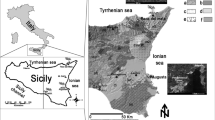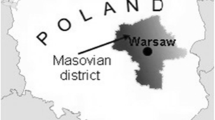Abstract
The lead, copper, zinc, and magnesium levels of scalp hair taken from 153 children aged 1–15 yr and young people (16–18 yr) with selected neurological disorders (hyperexcibility, loss of consciousness, and epileptiform convulsions of an unknown origin, etc.), were measured using the atomic absorption spectrometry method and then compared with a control group of healthy children (n=108). The research indicated significantly reduced mean levels of magnesium in the hair of children suffering from selected neurological diseases (in children aged 11–15 yr of age, above 30%; up to 5 yr of age, nearly 30%; the differences were statistically significant at p<0.05) and slightly decreased mean levels of copper (differences statistically significant at p<0.05, particularly in the 11 to 15-yr category). Differences in zinc levels in hair were inconsiderable (not statistically significant in any age groups). The lead level in the hair of the above-mentioned group of children was exceeded in relation to the control group (a statistically significant difference at p<0.05 for the total group). A more than twofold decrease in the mean value of the Mg/Pb ratio (and a nearly 30% decrease in the value of the Mg/Zn ratio) in the hair of children suffering from neurological diseases suggests that the high toxicity of lead accompanying, among other things, magnesium deficiencies might be a cause of the observed disorders in children.
Similar content being viewed by others
References
A. Taylor, Usefulness of measurements of trace elements in hair, Ann. Clin. Biochem. 23, 364–378 (1986).
M. Dastych and O. Vlach, Zinc status in patients with idiopathic scoliosis, Spine 15, 65–66 (1990).
L. M. Klevay, B. R. Bistrian, R. C. Fleming, and Ch. G. Neumann, Hair analysis in clinical and experimental medicine, Am. J. Clin. Nutr. 46, 233–236 (1987).
Z. Krejpcio, D. Olejnik, R. Wójciak, K. Kielczewska, and J. Gawęcki, Assessment of the content of calcium, magnesium, zinc and copper in hair and serum of children with hyperactivity, Polish J. Environ. Studies 6(Suppl.), 89–92 (1997).
K. A. Shrestha and A. E. Carrera, Hair trace elements and mental retardation among children, Arch. Environ. Health 43, 396–398 (1988).
K. A. Shrestha and A. Oswaldo, Trace elements in hair of epileptic and normal subjects, Sci. Total Environ. 67, 215–225 (1987).
L. Wecker, S. B. Miller, S. R. Cochran, D. L. Dugger, and W. D. Johnson, Trace element concentrations in hair from autistic children, J. Ment. Defic. Res. 29, 15–22 (1985).
J. G. Dorea, M. R. Horner, V. L. Bezerra, M. G. Pereira, and J. B. Salomon, Hair zinc levels and nutritional status in urban children from Ilheus, Bahia, Brasil, Hum. Nutr. Appl. Nutr. 36A, 63–67 (1982).
T. Kozielec, D. Strecker, G. Durska and K. Radomska, The relationship between hair lead content of 0–12 month infants and the method of their feeding, Bromat. Chem. Toksykol. 30, 69–74 (1997) (in Polish).
M. Bergomi, P. Borella, and G. Fantuzzi, Sangue, denti e capelli: tre diverse matrici utilizzate per valutare I’esposizione al plombo e a cadmio in bambini residenti in zona industriale, Ann. Ig. 1, 1185–1196 (1989).
J. Chlopicka, P. Zagrodzki, Z. Zachwieja, M. Krośniak, and M. Folta, Use of pattern recognition methods in the interpretation of heavy metals content (Pb, Cd) in children’s scalp hair, Analyst 120, 943–945 (1995).
A. A. Golow and E. E. Kwaansa-Ansah, Comparison of lead and zinc levels in the hair of pupils from four towns in the Kumasi Municipal Area of Ghana, Bull. Environ. Contam. Toxicol. 53, 325–331 (1994).
B. Nowak, Contents and relationship of elements in human hair for a non-industrialised population in Poland, Sci. Total Environ. 209, 59–68 (1998).
D. Olejnik, Z. Krejpcio, H. Strugala-Strawik, R. Wójciak, and J. Gawęcki, The blood and hair lead contents in children as indices of environmental exposure, Ped. Polska 72, 529–534 (1997) (in Polish).
B. A. Revich, Lead in hair and urine of children and adults from industrialized areas, Arch. Environ. Health 49, 59–62 (1994).
M. Schumacher, J. L. Domingo, J. M. Llobet, and J. Corbella, Lead in children’s hair, as related to exposure in Tarragona Province, Spain, Sci. Total Environ. 104, 167–173 (1991).
A. K. Srivastava and B. N. Gupta, The role of human hairs in health and disease with special reference to environmental exposures, Vet. Hum. Toxicol. 36(6), 556–560 (1994).
Y. Takagi, S. Matsuda, S. Imai, Y. Ohmori, T. Masuda, J. A. Vinson, et al., Trace elements in human hair. An international comparison, Fukui Prefect. Inst. Public Health Res. Rep. 23, 13–30 (1985).
A. Tracqui, M. A. Bosque, V. Costa, P. Kintz, F. Siegel, and P. Mangin, Lack of relationship between hair lead levels and some usual markers (blood lead levels, ZPP, urinary ALA-D) in occupationally exposed workers, Ann. Biol. Clin. 52, 769–773 (1994).
M. Wilhelm, D. Hafner, I. Lombeck, and F. K. Ohnesorge, Variables influencing cadmium concentrations in hair of pre-school children living in different areas of the Federal Republic of Germany, Int. Arch. Occup. Environ. Health 60, 43–50 (1988).
A. Chatt and S. A. Katz, Hair Analysis. Applications in the Biomedical and Environmental Sciences, VCH, Weinheim (1988).
T. Kozielec and A. Drybańska-Kalita, Content of lead and cadmium in the hair of children in the Szczecin population, Wiad. Lek. 47, 114–117 (1994) (in Polish).
G. Bagliano, F. Benischek, and I. Huber, A rapid and simple method for the determination of trace metals in hair samples by atomic absorption spectrometry, Anal. Chim. Acta 123, 45–56 (1981).
D. C. Paschal, E. S. DiPietro, D. L. Phillips, and E. W. Gunter, Age dependence of metals in hair in a selected U.S. population, Environ. Res. 48, 17–28 (1989).
H. G. Petering, D. W. Yeager, and S. O. Witherup, Trace metal content of hair. II. Cadmium and lead of human hair in relation to age and sex, Arch. Environ. Health 27, 327–330 (1973).
A. Chattopadhyay, T. M. Roberts, and R. E. Jervis, Scalp hair as a monitor of community exposure to lead, Arch. Environ. Health 32, 226–236 (1977).
L. M. Klevay, Hair as a biopsy material. III. Assessment of environmental lead exposure. Arch. Environ. Health 26, 169–172 (1973).
M. Anke and M. Risch, Haaranalyse and Spurenelementstatus, VEB Gustav Fisher Verlag, Jena, (1979).
B. Dudek, Toxicological effects of lead in children, Med. Pracy 46(Suppl. 1), 101–113 (1993) (in Polish).
J. Durlach, Le magnésium en pratique clinique, J. B. Bailliere Editions Medicales Internationales, Paris (1985).
Author information
Authors and Affiliations
Rights and permissions
About this article
Cite this article
Lech, T. Lead, copper, zinc, and magnesium content in hair of children and young people with some neurological diseases. Biol Trace Elem Res 85, 111–126 (2002). https://doi.org/10.1385/BTER:85:2:111
Received:
Revised:
Accepted:
Issue Date:
DOI: https://doi.org/10.1385/BTER:85:2:111




